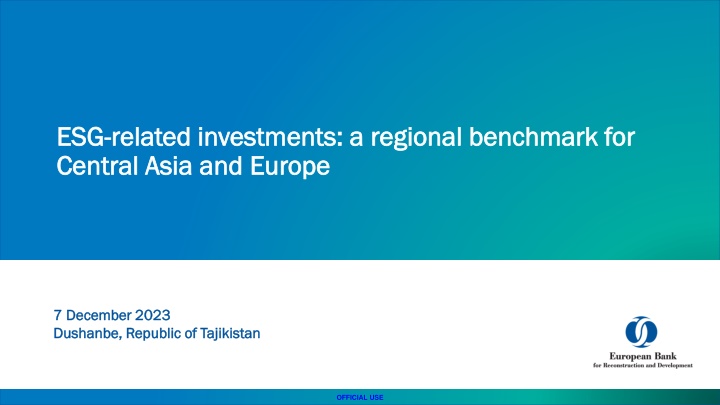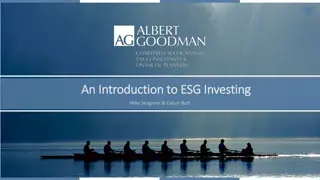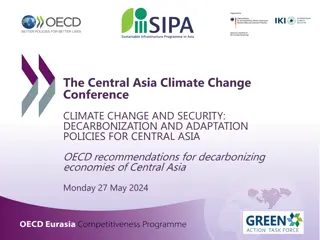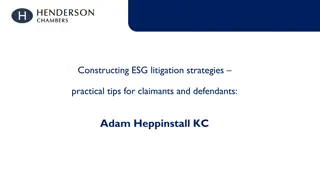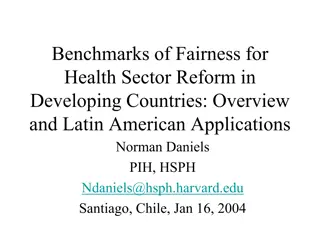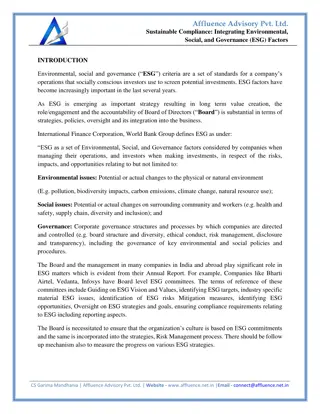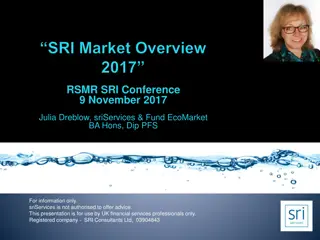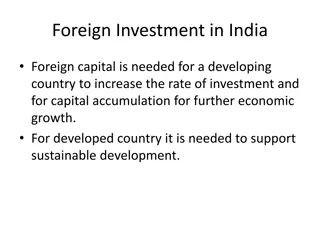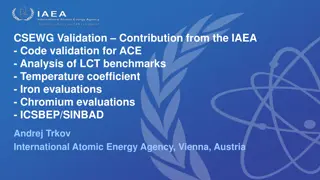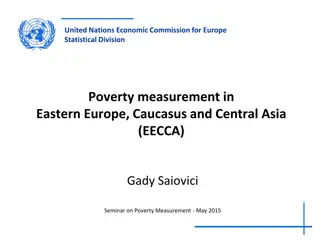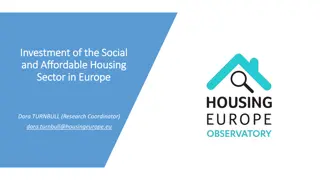ESG Investment Benchmarks: Central Asia and Europe Pathways
Importance of ESG-related investments as regional benchmarks for Central Asia and Europe, focusing on achieving a peak in emissions and rapid reductions to limit global temperature rise to 1.5°C. The financial sector's response to climate change, regulators' emphasis on climate governance, and the EBRD's commitment to Paris Alignment are also highlighted
Uploaded on Mar 07, 2025 | 1 Views
Download Presentation

Please find below an Image/Link to download the presentation.
The content on the website is provided AS IS for your information and personal use only. It may not be sold, licensed, or shared on other websites without obtaining consent from the author.If you encounter any issues during the download, it is possible that the publisher has removed the file from their server.
You are allowed to download the files provided on this website for personal or commercial use, subject to the condition that they are used lawfully. All files are the property of their respective owners.
The content on the website is provided AS IS for your information and personal use only. It may not be sold, licensed, or shared on other websites without obtaining consent from the author.
E N D
Presentation Transcript
ESG ESG- -related related investments: a regional benchmark for investments: a regional benchmark for Central Asia and Central Asia and Europe Europe 7 December 2023 7 December 2023 Dushanbe, Republic of Tajikistan Dushanbe, Republic of Tajikistan OFFICIAL USE
A 1.5 C pathway requires a peak in emissions as soon as possible and rapid reduction thereafter Global GHG emissions Global GHG emissions, GtCO2e p.a. To achieve the Paris Agreement goal of limiting the temperature rise to 1.5 C, global CO2 emissions must reach net zero by 2050, but must also peak as soon as possible as soon as possible, fall rapidly thereafter and be halved by around 2030. Historical data 1 Current trend 1.5 C pathway taking action now1 peak 1 1.5 C pathway 5y delay in action1 Global warming is a function of cumulative GHG emissions. To ensure emissions remain consistent with global temperature goals, they must remain within a carbon budget estimated to be between 420 and 580 GtCO by the IPCC in 2018. 3 2 Integral area under the curve must be below the carbon budget 2 If the peak in emissions is postponed, emissions will need to fall more rapidly. 3 Source: Illustrative pathways based on IPCC SR1.5 Report OFFICIAL USE 2
Climate Change and the Financial Sector Regulators Regulators are increasingly focusing on climate governance in the financial sector and expecting more climate related disclosures. 21 regulators in the EBRD region members of the Network for Greening Financial Systems (NGFS) Network for Greening Financial Systems (NGFS) Why FIs should act now: 21 regulators in the EBRD region are now Resilience to regulatory changes Improved/sustained capacity to raise capital by responding to investors demands Resilience to scrutiny from credit agencies Addressing risk blind spots in the portfolios New low-carbon origination opportunities Maintaining market leadership role in rapidly changing environment Investors Investors are increasingly focusing on climate change driven by their own Paris Alignment commitments as well as their recognition of financial risks resulting from climate change and regulatory pressures. Rating Rating agencies agencies are are starting to include climate risk in credit ratings IFRS Global Accounting Body has launched the IFRS Global Accounting Body has launched the International Sustainability Standards Board Board, to establish globally consistent climate disclosure standards for financial markets which will build on the TCFD framework TCFD framework. With the majority of financial institution in the EBRD region reporting under IFRS, this naturally raises the bar on climate related disclosures. International Sustainability Standards Businesses across all sectors Businesses across all sectors need to act increased risks resulting from climate change. This may require some financing restrictions but creates new origination opportunities for FIs with the right tools and products. need to act to reduce emissions and prepare for the Financial institutions Financial institutions are moving fast in adopting best practice to gain competitive advantage, but emerging markets are lagging behind (with the exception of a few frontrunners). OFFICIAL USE 3
EBRD is moving towards Paris Alignment Under the new Green Economy Transition Approach 2021-2025, the EBRD will increase green financing to more than 50 per cent of its annual business volume by 2025. To date, the EBRD has signed 36 billion in green investments andfinanced over 2,000 green projects, which are expected to reduce 104 million tonnes of carbon emissions yearly. As of 1 January 2023, all EBRD new financing is aligned with the goals of the Paris Agreement, including FI transactions. OBJECTIVES 50% 25 million tonnes Paris Alignment Target annual GHG emissions reductions over 2021-2025 All EBRD new financing shall be aligned with the goals of the Paris Agreement from Jan 2023 2025 target for the share of EBRD annual green investment, from average share of 40% OFFICIAL USE 4
Financial Institutions can take proactive steps Guiding principles for transition Guiding principles for transition plan preparation are common to all plan preparation are common to all What is a transition plan? What is a transition plan? Clear commitment Clear commitment A transition plan sets out the steps through which an organisation will improve its business practices in relation to climate change, leading to Paris-aligned financial flows. These steps will be set out as clear, time-bound milestones. Banks commit to supporting the implementation of the Paris Agreement. Action plan Action plan Actions should be defined for the short, medium and long term Disclosure Disclosure Public disclosure is at the centre of credible transition plan implementation. EBRD Paris alignment methodology
